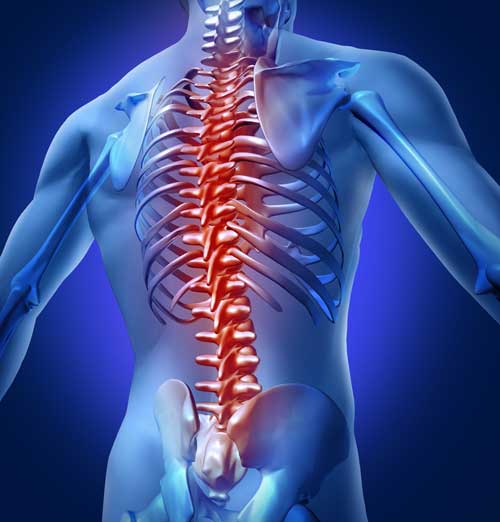
Back Pain & Sciatica
Back pain is something most people will feel at least once in their lifetime. It can range from discomfort to excruciating electric pain that is all consuming. It does have a lot of causes. The following are some examples:
• Posture – bad habits or congenital scoliosis (curvature of the spine)
• Muscle over-use and tightness
• Repetitive strain e.g. A brick layer laying bricks; computer users clicking the mouse
• Sporting activities e.g. skiing, running, impact sports, rugby.
• Age-related degenerative change.
• Tumours and cancers
Once there is muscular imbalance in the back, it will cause tightness. The more the muscles tighten up the more discomfort is felt. There are several structures that are very important in the back: the vertebrae or back bone, the ribs, and the discs that sit between the vertebrae. The spinal cord, part of the central nervous system, is also very important. It relays all the messages coming from the brain to all the muscles and organs in the body. The discs are made of cartilage connective tissue. They act like little shock absorbers. Unfortunately they can get injured, either from wear and tear or an event such as a sudden impact. If the disc becomes damaged it can extrude into the spinal nerves and compress them. The loss of disc height can make the vertebrae compress on one side. This can also lead to the spinal nerves being compressed. Why is this important? Well, a pinched or compressed nerve is very painful. It is distinguished by sharp electric pain. Sciatica, shooting pain down the buttock and back of the leg, is a good example of this.
Acupuncture is very helpful in this situation. The treatments include taking a detailed clinical history and examination of the back. This can involve various muscle tests and postural analysis. The focus of the treatment is to release the specific spinal segments that are creating the spinal compression.
Acupuncture releases the tightness in the small muscles of the spine to help create more space for the nerves. Diagnosis and treatment is based upon identifying the specific imbalances in the muscles and the body as a whole. Hence, acupuncture allows the body’s own mechanisms to heal itself. It also aims to create better spinal alignment for improved biomechanical movement.
Remedial massage is usually also helpful for this situation. It consolidates the acupuncture treatment and helps with manual tissue release. However, in some really acute circumstances we recommend acupuncture on its own as too much hands-on manipulation can actually aggravate the irritation and inflammation. This can cause pain symptoms to temporarily increase. Acupuncture in almost all cases will be helpful in the treatment of sciatica and back pain.
In acute cases the body can respond to treatment very rapidly. One or two treatments may be all that is necessary. For long-standing or more chronic injuries, a course of acupuncture may be necessary. We usually recommend four sessions, at least once a week, to gauge the response. Then reassess to see whether further treatments are necessary. It is also recommended to have regular “tune up” or maintenance treatments to help prevent a severe attack re-occurring. This ranges from monthly to 3 monthly treatments.
If you would like to make an appointment please contact us
To view a short demonstration of an acupuncture lumber treatment please check the videos section of the website.
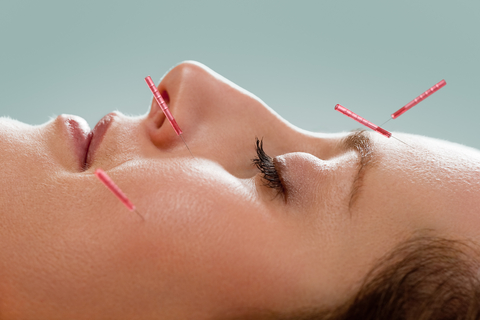
Facial Rejuvenation Acupuncture
What is facial rejuvenation acupuncture?
Facial rejuvenation acupuncture is a holistic natural anti-aging technique. Fine filiform acupuncture needles are inserted into specific points on the face and throughout the body. The aim is to slow down the aging process and make you look more vibrant, supple and youthful whilst also improving your general health and wellbeing.
How does it work?
Acupuncture works by activating the flow of oxygen (qi) and blood to the face. This can result in the reduction of fine lines, wrinkles and sagging. In specific terms, acupuncture can increase muscle tone by way of improving facial elasticity. The increased localised circulation that results from needle insertion can lead to capillary dilation giving rise to more production of collagen and elastin. “A 1996 report in the International Journal of Clinical Acupuncture postulated that among 300 cases treated with Cosmetic Acupuncture, 90% had marked effects with one course of treatment. The effects include: skin becoming more delicate, improvement of elasticity of facial muscles, ruddier complexion, and overall rejuvenation.”
Zhang, Q. and Zhu, L. (1996). Meridional Cosmetology: Report of 300 Cases with Discussion of Underlying Mechanism. The International Journal of Clinical Acupuncture, pp 401-405.
More about acupuncture
As many are aware, acupuncture is a holistic form of medicine. This means that for acupuncture to work in its entirety and for you to get the best results, a thorough and comprehensive history will be taken and any subtle or minor imbalances found will be treated. In essence, the treatment works as 2 in 1 benefit for YOU the client. Points on the face treat the specifics of collagen and blood flow as stated above and other points (usually on the limbs) will be added to help balance your general health and thus assist in achieving long term benefits.
What is involved in the treatment?
We will take a comprehensive health history to begin with and determine the best acupuncture point prescription for you based on your specific needs.
Acupuncture needles will be placed at multiple points around wrinkles and parts of the face that require treatment. There will also be needles placed on the peripheries of the body. Peripheral points will mainly function to re-balance your body, in some cases to remove toxins and other cases to increase whole body blood flow.
You will be in a relaxed horizontal position with the needles in place for 20-30 minutes.
How long until I can see results?
We recommend a course of ten treatments. As this is a natural approach to slowing down the ageing process, progressive treatments are recommended. To achieve optimum results, we encourage twice weekly treatments for the first two weeks, followed by weekly sessions. You should start seeing some pleasing results after four to five weeks when the imbalances are corrected, toxins have been removed and better general qi and blood flow have been increased. It usually takes this time frame for new collagen to be produced and for fine lines to start to diminish.
Other benefits
Acupuncture can assist with sleep disturbances, increase energy, boost immunity and lift your mood. All of these general health benefits will assist your treatment goals for reduction in wrinkles and a more youthful and glowing complexion. Beauty most definitely comes from within.
Are there any risks or side effects?
Acupuncture is almost entirely risk free. Perhaps it is fair to say that the only risk is that you will look and feel great. Sometimes there is some minor bruising or redness that develops at insertion points post- treatment, however this is temporary and will not impact on the effectiveness of the treatment.
Suitability
Almost anyone can benefit from facial rejuvenation acupuncture. However, if you suffer from severe migraines, have high blood pressure, or if you are on blood-thinning medications or pregnant, cosmetic acupuncture is not recommended.
Treatment course
Ten facial rejuvenation acupuncture sessions constitute a course. For optimum results, it is recommended that an entire course be completed.
Recommended strategy is two sessions per week for the first two weeks; then one session per week for the next six weeks.
Gradual improvement should be noted between each of the sessions.
Results last between two to five years.
Lifestyle factors will influence results. For example, heavy sun exposure, sleep deprivation, smoking and high alcohol consumption will reduce the beneficial effects of treatment.
Fees
$100 a session, which incorporates a discount to assist with limited budget.
Purchase ten treatments in advance and receive one free treatment as an added bonus.
Can I claim with private health funds?
Yes. You can claim the same way you would for regular acupuncture. Amounts vary depending on your particular choice of plans. We do have HICAPS available. Most are able to claim on the spot and only pay the gap fee. Please note you will need to bring your Health Fund card to the clinic to do this.
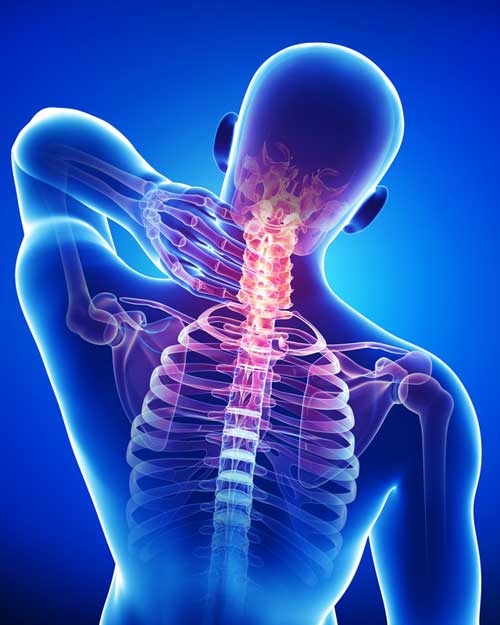
Neck & Mid Back Pain
Neck pain is discomfort, pain (dull and sharp) or tightness occurring from the shoulder and up to your skull.
Symptoms include:
- Stiffness
- Muscle spasm
- Muscle ache
- Nerve pain – sharp electric shooting pain
- Headaches
- Reduced range of motion – difficulty turning head to look over shoulder, bending or looking up and down.
Neck pain can even cause pressure or a burning sensation down your arms and hands. Quite often, “tennis elbow” or lateral epicondylitis has a component that stems from compression in the neck or upper thoracic spine.
You neck is made up of several structures: bones, muscles, ligaments, tendons, nerves, lymphatics. You have seven cervical vertebrae that stack up on top of each other. Between each one there is a cartilage disc or shock absorber. Spinal nerves exit through the gaps between each of these vertebrae. The nerves activate and send signals to your muscles to make them move. The neck is designed to support your head and allow movement. Any abnormalities, inflammation or injury can cause neck pain and stiffness.
The most common cause of neck pain is muscle stiffness and inappropriate posture. Extensive sitting at the computer, for instance, usually results in some sort of neck problems along the way.
Some other causes are:
- Whiplash and motor vehicle accidents. Sudden application of the vehicle’s brakes causes a whip-like movement of the body and forces the neck into a position it would not normally be in. This can upset neck alignment or even cause damage to the ligaments that support the neck. It can be a severe injury with long-lasting detrimental effects. However, acupuncture and massage are beneficial treatments to alleviate the results of this type of injury.
- Muscle strain: physical activity, repetitive strain, lack of use, even falling asleep in an awkward position on the couch.
- Degenerative disc disease
- Herniated disc
- Osteoarthritis
- Compression e.g. head stand in yoga
Acupuncture and massage are an effective way to get pain relief from neck disharmonies. It includes taking a detailed medical history and a physical exam. Most often there are various “trigger points” or tight bands of muscles in the upper back. These points relate to the pain and limited movement of the neck. Acupuncture utilizes these “active” trigger points for the insertion of needles to release the muscle spindles and return muscles to their normal length. It also helps free up agitated nerves and reduce inflammation. Acupuncture also treats the body holistically. Sometimes the cause of neck pain can come from other sources. For example, pressure coming from further down the thoracic spine can transfer up to the neck region. This needs to be addressed as well for there to be a positive result.
Mid and upper back pain (thoracic spine)
This section of the back suffers many of the same symptoms and causes for discomfort as for neck pain. An interesting factor here is that the chest can play a significant role. Tight or shortened pectoralis muscles (chest muscles) can pull the shoulder girdle anterior or forward. This places extra strain and pressure on the upper back muscles (trapezius, rhomboid, splenius capitis, erector spinae). The pain is often felt between the shoulder blades. It can then even travel up to the neck area. In this scenario it is important to address the tightness and disharmony in the chest as well as releasing and soothing the structures in the back.
Another dynamic component of the thoracic spine is the ribs. Ribs can also be problematic. Amazingly there are six points of contact or articulations with the ribs to the spine and the bone in your chest (sternum). The ribs need to be able to move freely to allow us to inhale by expanding the chest. They also protect organs in the upper torso – for example, the lungs, heart, pancreas and liver. If a rib is not in its correct position and cannot move properly, it will cause pain. Quite often there is a sharp pain between the shoulder blades. This can be accompanied by pain travelling across the ribs, sometimes even to the chest. Impact and trauma can cause the ribs to be mal positioned. Even a bad cough can sometimes cause rib displacement.
In these cases, it’s a matter of freeing up the spasm around the affected rib and vertebrae. Once the affected area has been identified, acupuncture is used on specific points to release the surrounding tissue. This helps alleviate the pain caused by the protective spasm and encourages the rib to return to its normal position and mobility. Combining acupuncture with remedial massage helps speed up the healing and corrective process.
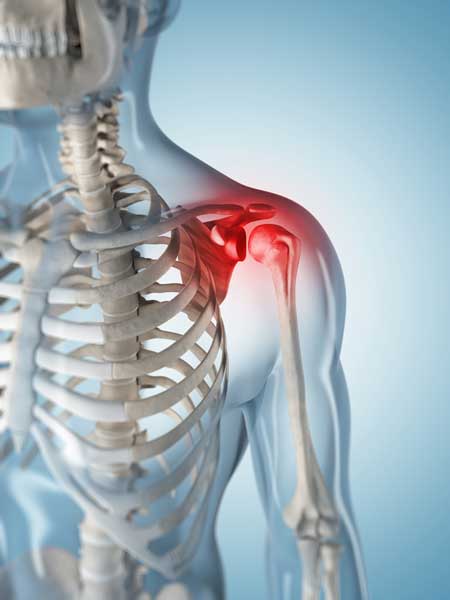
Frozen Shoulder
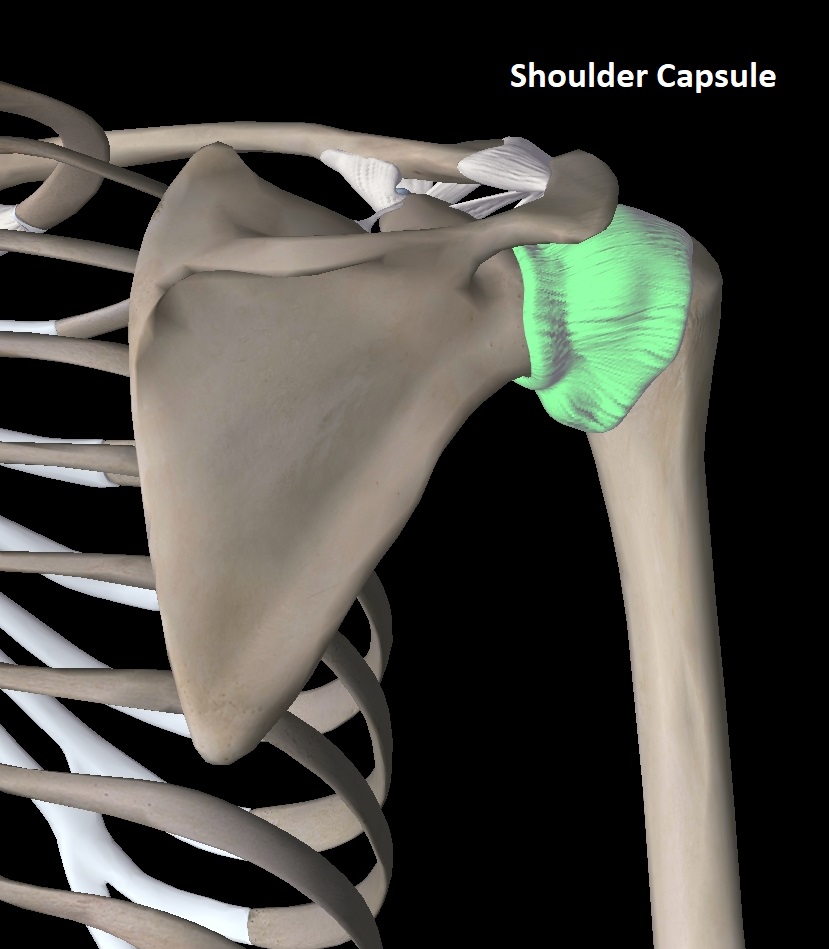
Frozen shoulder or adhesive capsulitis is very restrictive and painful. As the name suggests, it’s an adhesion or sticking of the folds of the shoulder joint capsule. The capsule is like a plastic covering the articulation of the humerus (arm bone) and scapulae (shoulder blade). In order for the shoulder to be able to move in all these amazing multiple directions, the capsule stretches and scrunches up where needed. In some of the places where the capsule scrunches up, it can adhere or stick together. It is not well understood why this occurs. Commonly a soft tissue injury and trauma to the shoulder can trigger it. There also seems to be an auto-immune component to frozen shoulder. There are risk factors that increase your chances of being affected. Some of these include: diabetes, stroke, lung disease, thyroid and heart disease. It usually lasts for one to three years. Recovery may occur spontaneously.
There are three stages of adhesive capsulitis:
- Freezing – most painful stage. Lasts six weeks to nine months.
- Frozen – adhesive stage with reduced range of motion. Usually lasts four to nine months.
- Thawing – pain reduces and range of motion slowly improves. Lasts five months to two/three years.
Pain and restricted movement are probably the main features of this condition. People generally have difficulty with raising the arm to the side (abduction) and internal rotation (putting the arm behind the back) and external rotation. The result is that day-to-day tasks become more difficult, e.g. doing up a bra, putting on a shirt or even combing your hair. Sleeping is usually problematic as lying still and restricted movement seems to increase the pain. Most common age group is between 40–60 years of age.
How acupuncture can help you
Frozen shoulder is restrictive and shortens muscles, with many trigger points or painful nodules that develop in the rotator cuff and the muscles surrounding the shoulder joint. By using specific acupuncture points these taut bands can be released. This will provide some relief from the shoulder pain. Acupuncture also promotes blood flow. Having better vascular supply to the area means a better supply of oxygen, leukocytes cells and lymphatic flow to help heal the adhered tissue. Acupuncture has also been shown to give pain relief. As frozen shoulder is often a long-term condition (one to three years), reducing the pain aspect can be an important component to healing and wellbeing.
The frozen shoulder might be a secondary symptom to one of the risk factors mentioned above. The wonderful thing with acupuncture is that it treats the body holistically. By taking into consideration all of the other medical problems, the treatment can have a more profound effect on the frozen shoulder.
Remedial massage is also indicated for this condition. The manual stimulation of the muscles and connective tissue also helps increase blood flow and increases circulation to the tissue.
Light mobility exercises are also helpful in encouraging the range of motion of the shoulder.
Other management strategies:
- Physical therapy
- NSAIDs (non steroidal anti-inflammatories)
- Corticoid steroids
- Manipulation under general anaesthetic
- Hydro dilation
- Surgery
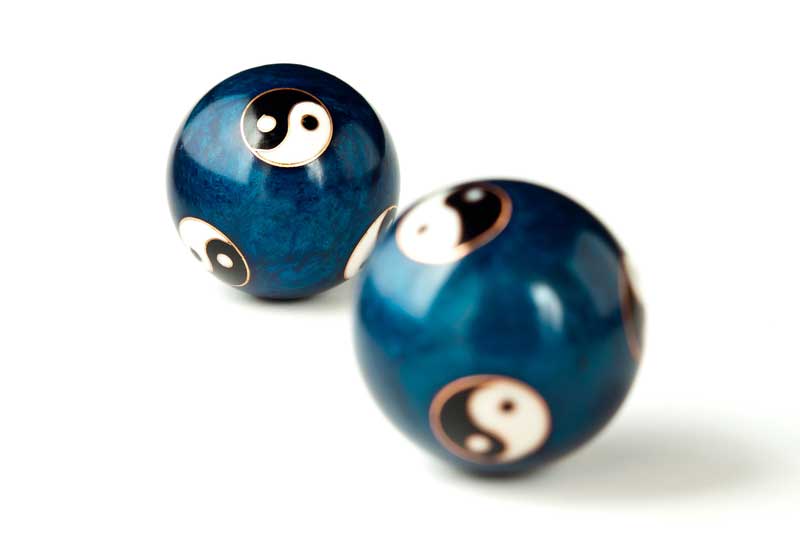
Stress and Anxiety
What is stress and anxiety?
Stress is a feeling of strain or pressure. We need stress for biological function. We use stress to adapt to new situations. Without stress, we would not evolve and develop. A basic example of positive stress is exercise. We train, overload or stress our muscles then adapt and grow bigger and stronger.
However, excessive stress can be bad and damaging. If your body and mind don’t get rest or a break from the stress, something breaks. If you’re awake for five days, the stress will put your mind and body at the limit of what could be lethal. Stress comes from many sources: relationships, work, responsibilities, kids, economics, duty, grief – even health.
Modern life is stressful. We have more technology and less time to use it. We are virtually connected to thousands of people but are speaking to each other less and less. Sitting at a desk plugging away at a computer, tension builds up and we have no release from the stress.
Consistently high stress levels have some of the following symptoms:
- Low energy
- Headaches
- Upset stomach, including diarrhoea, constipation and nausea.
- Aches, pains, and tense muscles.
- Chest pain and rapid heartbeat.
- Insomnia
- Frequent colds and infections.
- Loss of sexual desire and/or ability.
Anxiety can probably be summed up as a fear state. Excessive stress will usually lead to some level of anxiety. However, they can occur independently of each other.
Symptoms of anxiety:
- Feelings of panic, fear, and uneasiness.
- Problems sleeping.
- Cold or sweaty hands and/or feet.
- Shortness of breath.
- Heart palpitations.
- An inability to be still and calm.
- Dry mouth.
- Numbness or tingling in the hands or feet.
How acupuncture can help you
Acupuncture treatment is a great inclusion as part of your stress coping strategy. The logical solution to coping with stress is to eliminate the cause of that which is stressing you out. This is not always possible or practical. For example, you can’t stop caring for your family, doing your job or stop running your business.
Stress pushes our autonomic nervous system into an increased fight of flight stage. This is an up-regulated sympathetic nervous state. This is good for getting away from danger but not so good for day-to-day living.
Acupuncture works by stimulating nerve pathways to create a physiological effect in the body. Acupuncture can help down-regulate the sympathetic nervous system to be more in balance with the para-sympathetic state. The insertion of acupuncture needles releases neuro transmitters such an endorphins, enkephalins and endogenous opioids. All of these have a very relaxing effect on the body. An acupuncture session is sixty minutes of relaxing “me” time. It takes you out of the modern world to a safe place where you “sit” with yourself without distraction. This is of immense value. The effect of the acupuncture is usually quite immediate. After the session most people feel relaxed and contented. The effect usually lasts several days. Repetition of acupuncture treatment encourages a more sustained effect. If the stress has been long standing, usually a course of four sessions is recommended to make a better impact on reducing the stress level.
Stress management should also include some of the following:
- Psychologist/psychotherapy/counselling – having an independent sounding board can be stress-liberating. The ability to express everything you feel in a non-judgemental, neutral, confidential setting can be both energizing and restorative.
- Good/real food – the less processed food, the better. You are what you eat. It’s true.
- Exercise – endorphins help to burn off the anxious energy.
- Examination of your goals and expectations. Are you spreading yourself too far or too thin? Re-evaluation of what is realistic may put things in better perspective. Achievable goals are great goals.
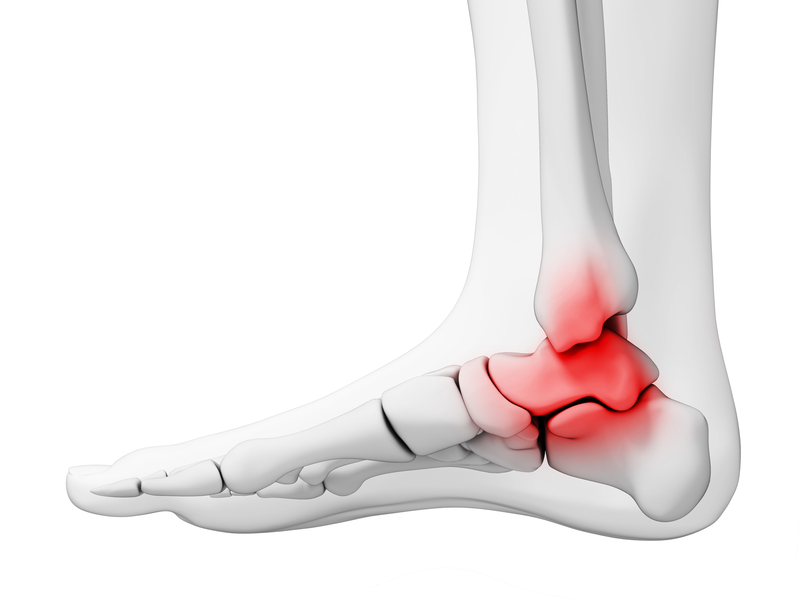
Plantar Faciitis
Plantar fasciitis is a common painful disorder affecting the heel and underside (plantar) aspect of the foot. It is usually caused by a scarring and inflammation of the connective tissue (fascia) that runs from the heel to the toes. It’s what forms the underside arch of your foot. Common symptoms are pain in the centre or side of the heel. This is the site of the insertion of the tendon into the bone.
It has often been classified as an over-use injury associated with sports and excessive standing. This results in an inflammatory process leading to pain and discomfort. However, more recent thoughts are that it is also associated with degenerative change due to aging. It is more common among people with excessive pronation of the foot or flat footedness. Pronation is the way the foot rolls inward when you walk and run. Some people pronate more (over pronation) or less (under pronation) than others. In these cases orthotics or shoe inserts are often prescribed to help with the symptoms. The opposite can also be true. Inactivity caused by obesity can also cause plantar fasciitis.
A common characteristic of this problem is a sharp pain with the first few steps of the day. Inflammation often stiffens the area when the body cools down as happens when we sleep for the night. It often feels similar to doing vigorous exercise and waking up very stiff the next day. Individuals with plantar fasciitis usually have difficulty with dorsiflexion, the movement of raising the toes towards the shin. The good news is that the condition usually resolves itself with time and responds to conservative treatment.
You would probably like to speed things up and shorten the healing time. Get back to walking without discomfort and doing active things with your family. Acupuncture and remedial massage are very helpful in speeding up the recovery process. Tight posterior chain (calves, hamstrings and gluteal) muscles can contribute to the condition, especially a dysfunctional and tight calf muscle. The calf attaches to the foot via the achilles tendon and then into the plantar fascia. By releasing the posterior chain and the calf muscle, you can get a great beneficial effect on the plantar fascia.
It is also worth checking the lower back and spinal alignment. If you are walking in a way that is compensating for dysfunction in the alignment of the body, you can place extra pressure on one foot. If you strike harder on one heel than the other, it will also tend to aggravate any irritations or discomfort of the dominant foot. Compression of the lower lumbar vertebrae can also cause referred pain to present itself in the heel. In these cases treating the back will quite often mend the foot. As they say, it’s all connected.
Please have a read of my personal experience with a painful foot in the blog section
